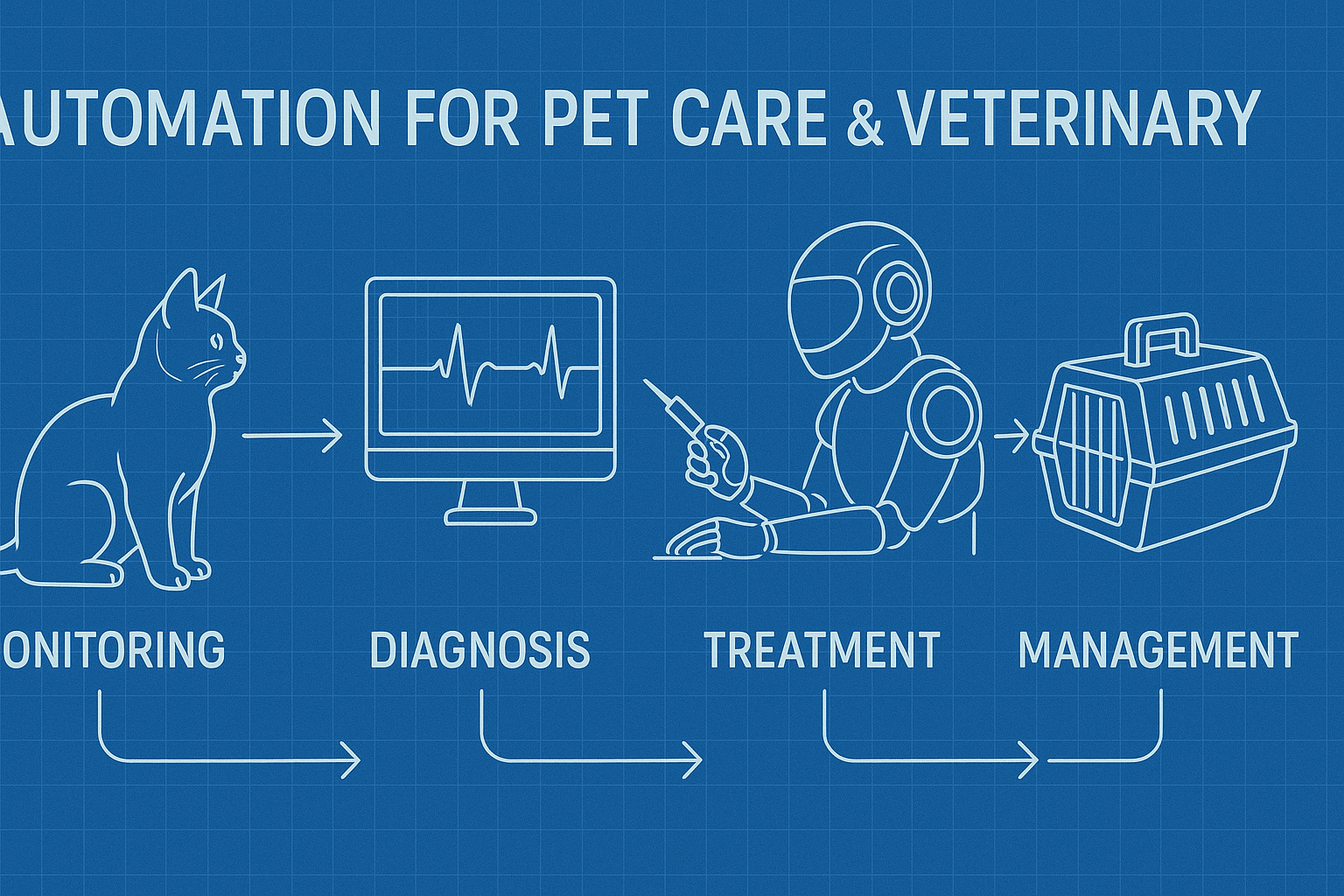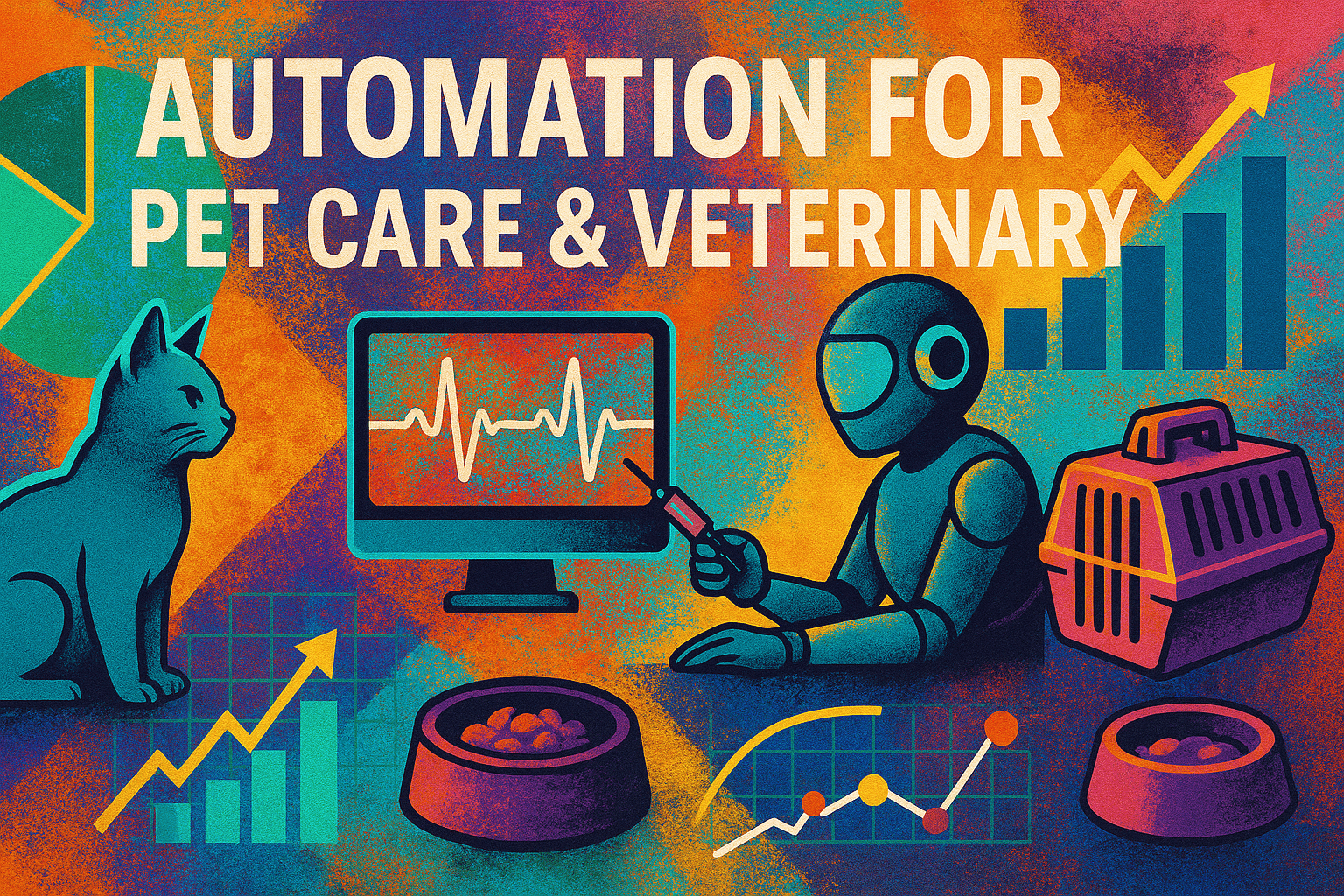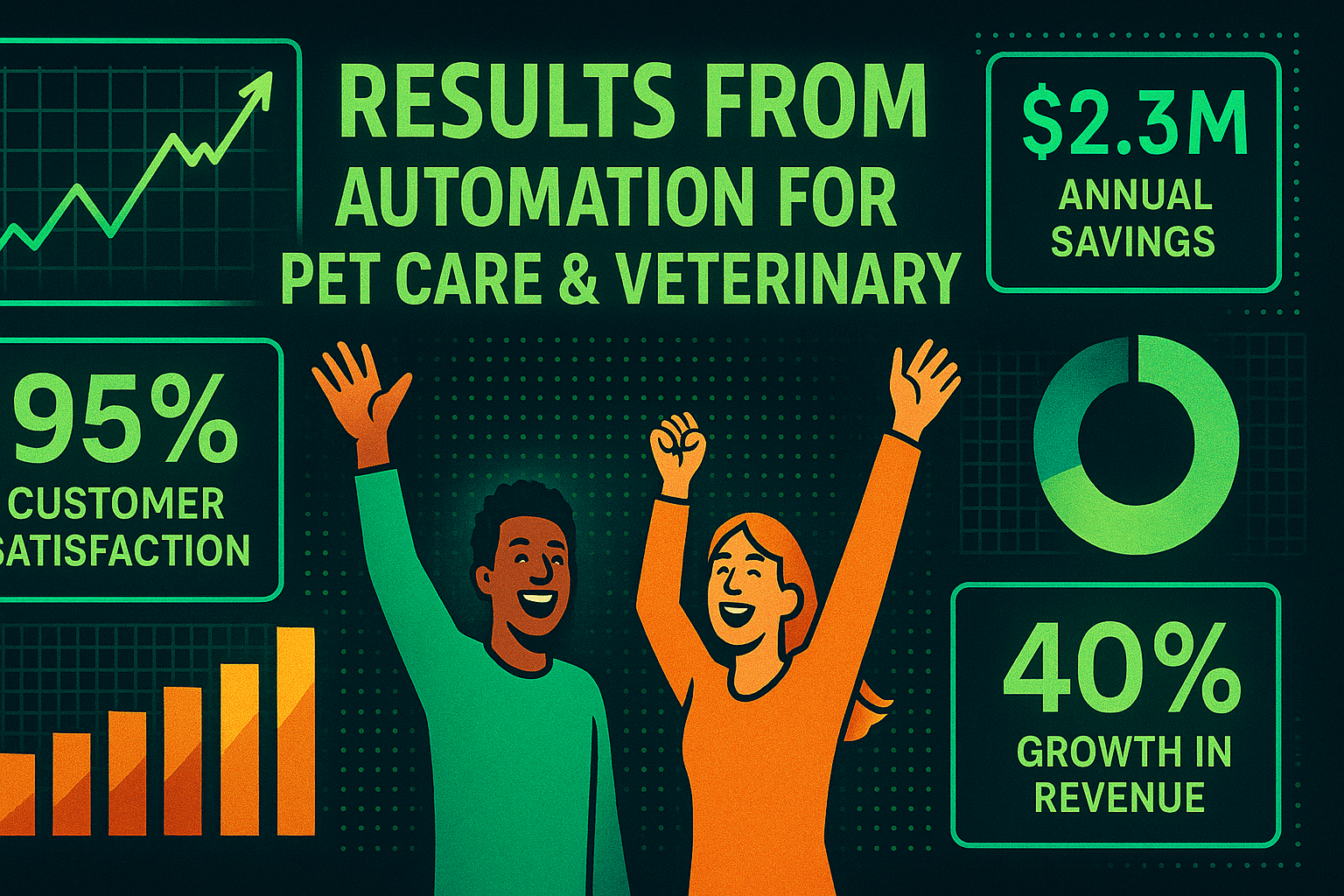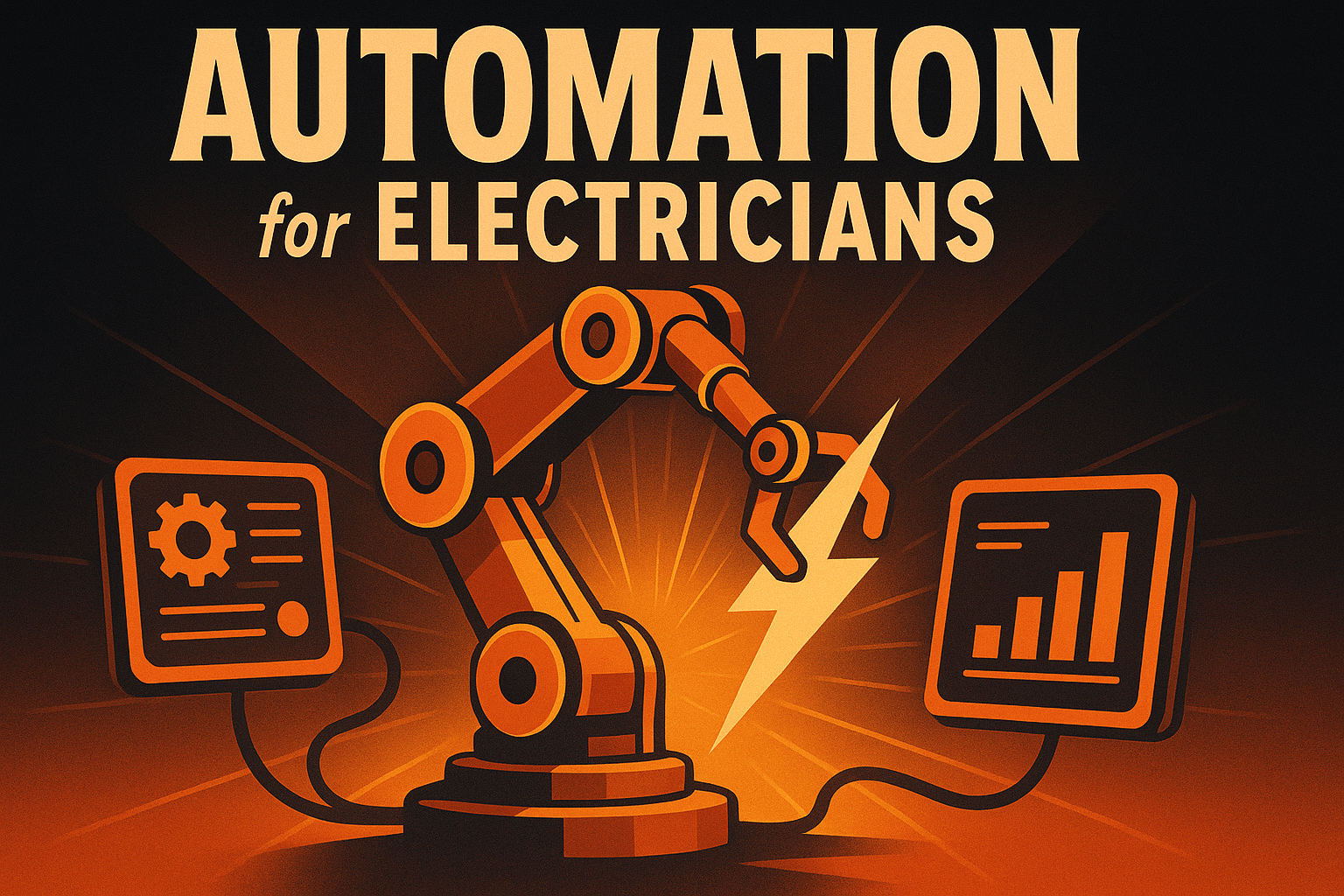Complete Automation Guide for Pet Care & Veterinary Practices in 2026
by Design Delulu Editorial · October 22, 2025

Smart, fast, and measurable. Here's how Automation helps Pet Care & Veterinary win.
Veterinary practices and pet care businesses face a unique challenge: delivering exceptional animal care while managing complex scheduling, client communications, inventory, compliance documentation, and revenue operations. Manual processes create bottlenecks that limit growth, increase staff burnout, and compromise the client experience. Pet owners expect instant responses, seamless booking, and proactive health reminders—expectations that overwhelm teams relying on spreadsheets, phone tags, and disconnected software.
Automation transforms this reality by eliminating repetitive administrative work, connecting fragmented systems, and creating scalable workflows that grow with your practice. From appointment confirmations and prescription refills to inventory alerts and follow-up care sequences, intelligent automation handles the predictable tasks so your team can focus on what matters: providing outstanding veterinary care and building lasting relationships with pet owners. The practices winning today aren't working harder—they're automating smarter, measuring what moves the needle, and continuously optimizing based on real data.

Why Automation Matters for Veterinary Practices
The veterinary industry operates under mounting pressure: staff shortages, rising client expectations, regulatory complexity, and thin profit margins. Every missed appointment, delayed follow-up, or inventory stockout directly impacts revenue and client retention. Traditional practice management approaches—relying heavily on manual coordination—simply can't scale to meet modern demands.
Consider the typical veterinary workflow: A client calls to book an appointment. Your receptionist answers, checks availability across multiple providers, confirms the time, manually enters details into your practice management system, sends a confirmation email, sets a reminder for follow-up, and adds the pet's medical history notes. That single booking requires six to eight manual touchpoints, each vulnerable to human error, delays, or inconsistency.
Automation eliminates this friction by creating intelligent workflows that handle routine tasks automatically while providing transparency and control. When properly implemented, automation delivers four critical advantages:
- Time Recovery: Staff reclaim 10-15 hours weekly by eliminating manual data entry, appointment confirmations, reminder calls, and routine follow-ups.
- Revenue Protection: Automated reminders reduce no-shows by 40-60%, while proactive reactivation campaigns recover lapsed clients worth thousands in annual revenue.
- Consistent Client Experience: Every pet owner receives timely, personalized communication regardless of which team member serves them or how busy your practice gets.
- Data-Driven Decision Making: Unified dashboards reveal exactly which services drive revenue, which marketing channels deliver quality clients, and where operational bottlenecks exist.
The veterinary practices thriving today share a common trait: they've moved from reactive, manual operations to proactive, automated systems that work 24/7. They're not chasing administrative tasks—they're serving more patients, delivering better outcomes, and building sustainable growth engines.
Core Automation Systems for Pet Care & Veterinary
Effective veterinary automation isn't about replacing human judgment with robots—it's about systematizing predictable workflows so your expertise focuses on complex medical decisions and relationship building. Here are the automation systems that deliver immediate, measurable impact:
Appointment & Scheduling Automation
Manual appointment management creates cascading inefficiencies: phone tag, double-bookings, no-shows, and constant calendar management. Automated scheduling systems transform this chaos into seamless coordination:
- Online Self-Booking: Clients schedule appointments 24/7 through branded portals that sync real-time availability across all providers and locations.
- Smart Confirmations: Automated text and email confirmations send 48 hours before appointments, with one-click rescheduling options that update your system instantly.
- No-Show Prevention: Multi-channel reminder sequences (text, email, phone) trigger at optimal intervals, reducing missed appointments by 45-65%.
- Waitlist Management: When appointments open due to cancellations, automated systems notify waitlisted clients immediately, filling gaps that would otherwise represent lost revenue.
Client Communication & Follow-Up
Timely, personalized communication builds trust and drives retention, but manual outreach is inconsistent and time-intensive. Communication automation ensures every client receives the right message at the right moment:
- Post-Visit Follow-Ups: Automated check-in messages send 24-48 hours after appointments, collecting feedback and identifying concerns early.
- Vaccination & Wellness Reminders: Date-triggered campaigns notify pet owners 30-60 days before due dates, with integrated booking links that convert reminders to scheduled appointments.
- Prescription Refill Automation: Systems track medication schedules and proactively notify clients when refills are due, with one-click reorder functionality.
- Educational Drip Campaigns: New pet owner sequences deliver condition-specific guidance, seasonal health tips, and preventive care education automatically based on pet profiles and medical history.
Revenue Operations & Analytics
Most veterinary practices operate with fragmented data across practice management systems, payment processors, marketing platforms, and scheduling tools. This fragmentation makes it impossible to understand true performance or optimize operations. Revenue automation creates a single source of truth:
- Unified Dashboards: Real-time visibility into key metrics—appointments booked, revenue by service line, client acquisition costs, retention rates, and average transaction values.
- Attribution Modeling: Track which marketing channels and campaigns drive quality clients, enabling smarter budget allocation and eliminating wasteful spending.
- Payment Automation: Integrated billing systems send invoices automatically, process payments securely, and trigger follow-ups for outstanding balances.
- Inventory Triggers: Automated alerts notify staff when medication or supply levels hit reorder thresholds, preventing stockouts and optimizing cash flow.

Implementation Roadmap: From Manual to Automated
Implementing automation successfully requires strategic planning, not random tool adoption. The practices that succeed follow a proven, phased approach that delivers quick wins while building toward comprehensive automation. Here's the four-phase roadmap that transforms veterinary operations:
Phase 1: Discovery & Goals (Week 1-2)
Effective automation starts with clarity about your current state, constraints, and desired outcomes. This discovery phase prevents costly missteps and ensures automation solves real problems:
- Process Audit: Map existing workflows from client inquiry through post-treatment follow-up, identifying manual touchpoints, bottlenecks, and error-prone steps.
- System Inventory: Document all current software, data sources, and integration points to understand technical constraints and opportunities.
- Goal Setting: Define specific, measurable objectives—reduce no-shows by 50%, recover 100 lapsed clients monthly, decrease administrative time by 12 hours weekly.
- Stakeholder Alignment: Secure buy-in from veterinarians, technicians, and front desk staff by demonstrating how automation reduces their pain points.
Phase 2: Blueprint & Architecture (Week 2-3)
With clear goals established, the blueprint phase designs your automation architecture—the systems, workflows, and measurement framework that will power your practice:
- Workflow Design: Create detailed automation sequences for each identified opportunity, specifying triggers, actions, conditions, and exception handling.
- Technology Selection: Choose platforms and tools that integrate seamlessly with your existing practice management system and scale with your growth.
- Data Governance: Establish naming conventions, tagging systems, and data quality rules that ensure clean, consistent information across all platforms.
- Measurement Plan: Define KPIs, tracking methods, and reporting cadence so you can prove ROI and optimize continuously.
Phase 3: Build & Launch (Week 4-6)
The build phase transforms blueprints into functioning automation, with rigorous testing and staff training ensuring smooth deployment:
- System Configuration: Set up automation platforms, create workflow sequences, configure integrations, and build custom dashboards.
- Quality Assurance: Test every automation thoroughly—verify triggers fire correctly, messages contain accurate information, and data flows between systems reliably.
- Staff Training: Conduct hands-on training sessions that show team members how to use, monitor, and troubleshoot automation systems effectively.
- Soft Launch: Deploy automation to a limited segment first (e.g., new clients only) to validate performance before full rollout.
Phase 4: Optimize & Scale (Week 7+)
Automation isn't set-it-and-forget-it—continuous optimization separates good results from exceptional performance. The optimization phase focuses on data-driven refinement:
- Performance Analysis: Review dashboards weekly to identify what's working, what's underperforming, and where opportunities exist.
- A/B Testing: Experiment with message timing, communication channels, content variations, and offer structures to maximize conversion rates.
- Workflow Expansion: Gradually automate additional processes as team confidence grows and initial workflows prove successful.
- Feedback Loops: Collect input from staff and clients regularly, using insights to refine automation and address unexpected friction points.
Measuring Success: KPIs That Matter
Automation delivers value only when you measure what matters. Vanity metrics—email open rates, social media followers, website visits—provide false comfort without revealing true business impact. Revenue-focused KPIs tell the real story:
Client Acquisition Metrics
- New Client Appointments Booked: Track monthly new client volume by source (organic search, referral, paid ads) to understand which channels deliver quality leads.
- Cost Per Acquisition (CPA): Calculate total marketing spend divided by new clients acquired. Target: $50-$150 depending on your average client lifetime value.
- Booking Conversion Rate: Measure the percentage of inquiries that convert to scheduled appointments. Benchmark: 60-75% for well-optimized systems.
Retention & Engagement Metrics
- No-Show Rate: Track appointment no-shows as a percentage of total scheduled visits. Target: Under 10% with automated reminder systems.
- Client Retention Rate: Measure the percentage of clients who return within 12 months. Healthy practices maintain 75-85% retention.
- Reactivation Success: Count lapsed clients (no visit in 12+ months) who return after automated reactivation campaigns. Target: 5-10% monthly reactivation rate.
Revenue & Efficiency Metrics
- Average Transaction Value: Monitor revenue per visit to identify upsell opportunities and service mix optimization needs.
- Revenue Per Available Hour: Calculate total revenue divided by available provider hours to measure capacity utilization.
- Administrative Time Saved: Quantify hours recovered through automation, then calculate the dollar value based on staff wage rates.

Industry-Specific Best Practices
Veterinary automation succeeds when it respects the unique characteristics of pet care businesses. Generic automation approaches fail because they ignore the emotional dynamics, regulatory requirements, and operational realities of animal healthcare. Apply these industry-specific strategies for maximum impact:
Match Automation to Buyer Journey Stages
Pet owners move through distinct stages when selecting and engaging with veterinary care. Your automation must align with these stages:
- Awareness Stage: Educational content about common pet health issues, breed-specific care guides, and preventive medicine importance.
- Consideration Stage: Social proof (reviews, testimonials, case studies), provider credentials, facility tours, and service comparisons.
- Decision Stage: Easy scheduling, transparent pricing, new client offers, and streamlined onboarding that reduces friction.
- Loyalty Stage: Personalized wellness plans, birthday messages, loyalty rewards, and proactive health reminders that demonstrate ongoing care.
Leverage Emotional Triggers Appropriately
Pet ownership is deeply emotional. Effective automation acknowledges this reality without exploiting it:
- Empathy in Automation: Use compassionate language in health reminders and follow-ups. "We care about Bella's health" resonates more than "You're overdue for vaccination."
- Celebrate Milestones: Automate birthday messages, adoption anniversaries, and treatment success acknowledgments that strengthen emotional bonds.
- Sensitive Timing: Adjust communication frequency and tone for clients dealing with serious illness or end-of-life decisions.
Prioritize Mobile-First Experiences
Over 70% of pet owners interact with veterinary services via mobile devices. Your automation must deliver flawless mobile experiences:
- Text Message Preference: SMS reminders achieve 98% open rates versus 20-30% for email. Default to text communication with email as backup.
- Mobile Booking: Ensure scheduling interfaces work perfectly on smartphones—large buttons, minimal typing, and instant confirmation.
- One-Click Actions: Enable appointment confirmations, rescheduling, and prescription refills with single-tap interactions.
Build Compliance Into Automation
Veterinary practices operate under strict regulatory requirements. Automation must support compliance, not compromise it:
Common Automation Pitfalls to Avoid
Even well-intentioned automation initiatives fail when practices make predictable mistakes. Avoid these common pitfalls:
Over-Automation Too Soon
Attempting to automate everything simultaneously overwhelms teams and creates chaos. Start with 2-3 high-impact workflows, prove success, then expand gradually. The practices that succeed automate appointment reminders and post-visit follow-ups first, establishing credibility before tackling complex revenue operations.
Ignoring Change Management
Automation changes how people work. Failure to address human factors—training, communication, buy-in—guarantees resistance and poor adoption. Involve staff in automation design, highlight how it reduces their pain points, and celebrate early wins publicly.
Choosing Tools Over Strategy
Many practices buy software first, then figure out how to use it later. This backwards approach leads to expensive tool sprawl and disconnected systems. Define your workflows and goals first, then select tools that fit your strategy—not the other way around.
Neglecting Data Quality
Automation amplifies whatever you feed it. Poor data quality—duplicate records, inconsistent formatting, outdated information—produces unreliable automation that frustrates clients and staff. Establish data governance rules before automating, and implement validation checks that maintain quality ongoing.
Set-and-Forget Mentality
Automation requires ongoing management and optimization. Markets shift, client preferences evolve, and new opportunities emerge. Practices that review performance weekly, test variations monthly, and adjust strategy quarterly achieve 3-5x better results than those treating automation as one-time implementation.
Real-World Application: Automation in Action
Consider how a mid-sized veterinary practice (3 doctors, 8 staff, 2 locations) implemented automation with measurable results:
Starting Point
- No-show rate: 22% (industry average: 15-20%)
- Receptionist spending 15 hours weekly on reminder calls
- Client reactivation: ad-hoc, no systematic approach
- No visibility into which marketing channels drove new clients
- Average client lifetime value: $1,850
Automation Implementation (8 Weeks)
- Week 1-2: Process audit, goal setting, stakeholder alignment
- Week 3-4: Automated appointment reminder system via SMS and email
- Week 5-6: Client reactivation campaigns for lapsed clients (no visit in 12+ months)
- Week 7-8: Attribution tracking and unified dashboard implementation
Results After 6 Months
- No-show rate reduced to 8% (saving 140+ appointments annually)
- Receptionist time saved: 12 hours weekly (redirected to client service)
- Reactivated 47 lapsed clients (representing $86,950 in recovered lifetime value)
- Identified that referral clients had 35% higher lifetime value than paid ad clients
- Overall revenue increase: 18% ($127,000 annually)
- Return on automation investment: 640% in first year
This practice succeeded because they followed the proven roadmap: started with high-impact workflows, measured what mattered, involved staff throughout, and optimized continuously based on data.
Getting Started: Your Next Steps
Veterinary automation delivers transformative results, but only when implemented strategically. Here's your actionable roadmap to begin:
Step 1: Audit Your Current State
Spend one week documenting your existing workflows. Track how much time staff spend on manual tasks, calculate your current no-show rate, and identify where client communication falls through the cracks. This baseline data proves ROI later.
Step 2: Identify Your Highest-Impact Opportunity
Choose one automation project that delivers quick wins and builds momentum. For most practices, this is either appointment reminder automation (immediate no-show reduction) or lapsed client reactivation (direct revenue recovery).
Step 3: Set Clear Success Metrics
Define exactly what success looks like: "Reduce no-shows from 18% to under 10% within 90 days" or "Reactivate 25 lapsed clients per month." Vague goals produce vague results.
Step 4: Choose Implementation Support
Decide whether to build automation in-house or partner with specialists. In-house works if you have technical expertise and bandwidth. Specialist partners accelerate implementation and reduce costly trial-and-error.
Step 5: Launch, Measure, Optimize
Deploy your first automation, track performance religiously, and iterate based on data. Small, continuous improvements compound into exceptional results over time.
Deliverables You Can Expect
A comprehensive veterinary automation engagement typically delivers:
- Tracking Plan: Detailed documentation of what you'll measure, how you'll measure it, and target benchmarks for each KPI.
- GA4/Server-Side Setup: Event tracking and e-commerce measurement configured to capture appointment bookings, service revenue, and client journey data.
- Custom Dashboards: Looker Studio or similar dashboards providing real-time visibility into appointments, revenue, marketing performance, and operational metrics.
- Attribution Model Settings: Multi-touch attribution configured to reveal which marketing channels and touchpoints drive quality clients.
- Automation Workflows: Fully configured appointment reminders, follow-up sequences, reactivation campaigns, and operational triggers.
- Documentation & Training: Comprehensive guides and hands-on training enabling your team to manage, monitor, and optimize automation ongoing.
Frequently Asked Questions
Let’s level up your Pet Care & Veterinary business
Need services that actually move the needle for Pet Care & Veterinary? See our approach, pricing, and timelines—then book a quick call.
Additional Resources
- Schedule a Strategy Call
Book a 30-minute consultation to discuss your practice's automation needs. We'll review your current workflows, identify quick-win opportunities, and outline a customized implementation roadmap.
- View Our Portfolio
Explore real automation implementations for veterinary and pet care businesses. See case studies, before-and-after metrics, and detailed breakdowns of workflows we've built for practices like yours.
- Free Automation Tools
Access free resources including automation readiness assessments, ROI calculators, workflow templates, and implementation checklists specifically designed for veterinary practices.
Related Reading

Discover how automation for electricians streamlines scheduling, invoicing, lead tracking, and customer follow-ups to boost revenue and efficiency. Get started today.

Discover how automation streamlines furniture & home decor operations with GA4 tracking, attribution modeling, and data-driven dashboards. Get your 90-day implementation roadmap.
